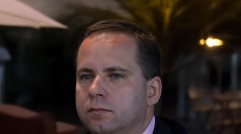Latina Genius Hailed ‘The Next Steve Jobs’ Is a Model for the Entire Education System
Paloma Noyola Bueno, a 12-year-old Mexican math genius who was dubbed "the next Steve Jobs" and became an international media sensation, has lived up to her name. Paloma - meaning dove in Spanish - has soared to new heights, proving that there are endless possibilities when you believe in yourself.
The impressive tween, who is the youngest of eight children, lives in Matamoros, Mexico and attends a school that borders a municipal waste dump. She lives with her family who makes a living by selling scrap metal and food in the streets. Life hasn't been easy, but she prevailed intellectually when given the right tools to succeed, thanks to her 32-year-old teacher, Sergio Juárez Correa.
Juárez Correa taught Noyola Bueno a powerful life lesson, that she has one thing that makes her the equal to any kid in the world - potential. Keeping this in mind, Correa adopted a "minimally invasive education" concept pioneered by Sugata Mitra, a professor of educational technology at Britain's Newcastle University. The formula worked and allowed his students to tap into their own curiosity and self-learning to solve problems.
Last year, Noyola Bueno, wowed the entire country by scoring the best in the nation with a maximum of 921 in Mexico's version of the SATs. In addition, Juárez Correa's students' scores in Spanish and math shot up significantly, with nine other students scoring over 900 in the math section of the standardized test.
After her success and Juárez Correa's teaching methods were featured in the Wired article, she was sent to Mexico City for a mental math competition and she continues to thrive in the media spotlight.
"If Paloma had the same opportunities or open doors as Steve Jobs, she probably would be a genius in this subject," Juárez Correa said, according to Agence France-Presse, Fox News Latino reported.
Noyola Bueno's story highlights the education system on a grander scale and allows us to take a closer look at teaching methods in the United States.
"The World Economic Forum ranks the U.S. just 49th out of 148 developed and developing nations in quality of math and science instruction," Wired reports.
"The fundamental basis of the system is fatally flawed," says Linda Darling-Hammond, a professor of education at Stanford and founding director of the National Commission on Teaching and America's Future. "In 1970 the top three skills required by the Fortune 500 were the three Rs: reading, writing, and arithmetic. In 1999 the top three skills in demand were teamwork, problem-solving, and interpersonal skills. We need schools that are developing these skills."
"That's why a new breed of educators, inspired by everything from the Internet to evolutionary psychology, neuroscience, and AI (Artificial Intelligence), are inventing radical new ways for children to learn, grow, and thrive, Wired adds. "To them, knowledge isn't a commodity that's delivered from teacher to student but something that emerges from the students' own curiosity-fueled exploration. Teachers provide prompts, not answers, and then they step aside so students can teach themselves and one another. They are creating ways for children to discover their passion-and uncovering a generation of geniuses in the process."
I wondered if this type of teaching method occurred in my home state of Massachusetts - and after some research and Facebook suggestions, I found out it does.
In Framingham, Massachusetts, the Sudbury Valley School, which was established in 1968 uses a similar model to Sugata Mitra's and Juárez Correa's. They too foster an environment "where students are able to develop traits that are key to achieving success: They are comfortable learning new things; confident enough to rely on their own judgment; and capable of pursuing their passions to a high level of competence."
One student recounted: "The full meaning of the school's philosophy didn't really come to me until I was out of it and entered adult life, when I found an area of focus that I was interested in and I really was disciplined about it. My own drive, my own motivation was applied to the area that I wanted to get into. Basically the school says you're responsible for your own education. You're always going to meet obstacles along the way; but if you put your mind to it and apply yourself to it, it's going to work out and it'll have more meaning because it comes from within you."
While the U.S. is making some steady gains in the overall number of high school students earning diplomas (with an increase in the percentages of African-American and Latino students graduating), some reports can be misleading.
"Today, almost 1.7 million of the 6.2 million Latinos age 18 to 24 do not have a high school diploma," Campaign for High School Equity Executive Director Rufina A. Hernández told VOXXI. "We all pay a price when that many young adults go out into the world without even the minimum preparation of a high school diploma.
Steve Moya, author of new book "Great Potential: Latinos in a Changing America," added "that it's becoming increasingly clear that, compared to other nations, the United States is falling behind academically as a whole, and specifically failing in educating Latinos."
Not all students in need can be exposed to the Sugata Mitra's teaching method, or be enrolled in Sudbury Valley School, but any teacher can learn from Juárez Correa's simple, yet effective approach. In the case of Noyola Bueno, all she needed was some guidance to discover her true potential on her own - even in the most dire circumstances.
Subscribe to Latin Post!
Sign up for our free newsletter for the Latest coverage!











